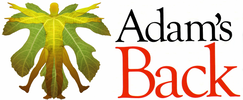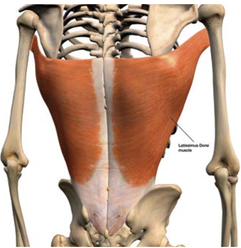Have you heard of the muscle, the latissimus dorsi? It’s often referred to as the ‘lats’. Exercises and gym equipment designed to maximise its bulk and streamline its V-shape are popular, but its role is far more than just looking good.Latissimus refers to broad and dorsi to the back. So, this Latin term simply means the broadest muscle of the back. And broad it is! This large reversed triangle attaches to a number of places in the upper and lower body. So, it plays an important role in connecting your top and bottom halves.
WHERE IS THE LATISSIMUS DORSI? It emerges from just below the midsection of your middle back to your sacrum, or tailbone. Place your hands on your hips. The curved bones below your thumbs are called your iliac crests — it attaches here on both sides, too. Rising from your lower ribs, it connects to the tips of each shoulder blade, then winds its way under the inside of your upper arm (humerus) around to the front. It’s amazing really, that a single muscle can bridge the lower and mid back, and anchor near your shoulders. No wonder part of its name means broad! WHAT DOES IT DO? A muscle’s function is to contract or shorten − to tighten, or relax − to lengthen. This is how your muscles move the body part or parts they’re attached to. Think about one of your quadriceps while you sit. As you contract this muscle, it shortens and straightens your knee. As it relaxes, your knee bends. Your latissimus dorsi works in the same way, only it moves different bones. At your shoulder, the latissimus dorsi draws your humerus backward, toward the side of your body, and twists inward. It also pulls the bottom tip of your shoulder blade down and towards your spine, which draws your shoulders down and back. This is great for your posture! But your lats is not only a shoulder-movement muscle; it does more than this... Research suggests that the latissimus dorsi contracts when we lean to the side, twist around, or flex and extend the spine, bending forwards or straightening up. This indicates that it’s important in stabilising and supporting our spine as it moves. Healthy, strong lats, then, could help to prevent back and pelvis problems. In fact, one 2013 study showed that strengthening this muscle helps to relieve pain in the area where the middle and lower back meet. There are various exercises and activities − like swimming and rowing − to strengthen the lats. Remember, because all muscles contract and relax, they can become tight too. Stretches can help release tension. If you have concerns or questions about your latissimus dorsi, ask us − we can also recommend the best exercises, activities and stretches for your body.
0 Comments
Leave a Reply. |
AuthorAdam's Back is a team of dedicated complimentary health professionals. Our aim is to support you in finding drug-free solutions for better health. Archives
July 2024
Categories |
Search by typing & pressing enter


 RSS Feed
RSS Feed